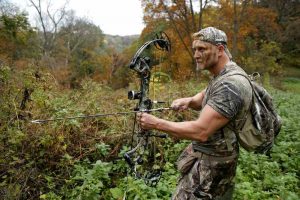23 Things You Need to Know About Hog Hunting in Florida

You have decided that this summer would be an excellent time to go hog hunting in Florida.
You won’t be the only one, as hog hunting in Florida is popular among hunters, second only to deer hunting.
It is also one of the fastest-growing segments of hunting across the United States.
According to Field & Stream, although you can hunt wild hogs in Florida all year round, Hog Hunting hunting is especially good in the summertime.
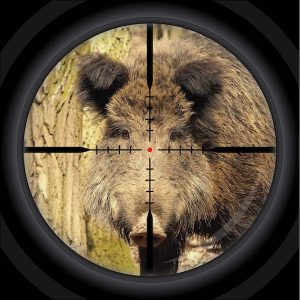
Wild Hogs Are An Invasive Species
Wild hogs are not native to Florida. Also called wild pigs, wild boars, or feral pigs, these animals are present in all 67 counties in Florida
It is an educated guess that these hogs were introduced to Florida by Spanish explorer Hernando DeSoto about 450 years ago.
Wild Hogs Are Smart
Wild hogs are crafty and intelligent creatures. They have an amazing sense of smell and can hear a pin drop, as the saying goes.
Their eyesight is not top-notch, but their other senses more than make up for this deficit.
While hunting wild hogs may seem like a matter of tracking, bagging one will not be a walk in the park.
You will need to know what you are doing, as this is one animal (other than a bear) who will charge you when under attack, so be sure to read these Tips and Tricks for a Successful Hog Hunting Trip.
Private Land Hunting
To hunt on private land, you need the landowner’s permission as wild hogs are considered livestock.
On private land, wild hogs can be hunted all year round without a limit to the amount you can bag. Hog Hunting in Florida can be a real adventure.
Some hunters think Florida is the best place to hunt because the weather is always good: The Low-Down on Florida’s Summer Hog Hunting Options.
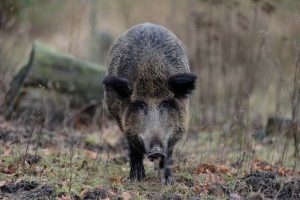
Florida Wildlife Management Area
Florida has one of the largest wildlife management area systems in the country.
In wildlife management areas (WMA’s), wild hogs can be hunted in most seasons except the spring turkey season.
Use the WMA Finder to locate the area you would like to hunt and find out what the regulations are.
An easy tutorial for FWC Wildlife Management Area Finder will show you how to look up a particular area for hunting.
License And Permit
While a hunting license is not required to hunt wild hogs in Florida, if you are hunting in a WMA, you will need a permit.
Three of the best state tracts for hog hunting in Florida are the Lower Econfina River WMA, Kicco WMA, and Myakka State Forest.
Check out the Florida Fish and Wildlife Conservation Commission website for more information on hog hunting.
Why Hunt Wild Hogs?
The population of wild hogs continues to grow at an alarming rate. As a non-native species, these hogs threaten the safety of native wildlife and crops.
Wild hogs are found in at least 35 states. The United States Department of Agriculture (USDA) estimates that Feral Swine has grown to at least 6 million in America, mostly in southern states.
Wild hogs cause a tremendous amount of damage to crops, degrade water quality, and inhibit forest regeneration.
The USDA estimates that the hogs cost the United States $1.5 billion each year in damage and pest control.
So if you decide to go hog hunting in Florida this summer you will be doing the entire nation a big favor!
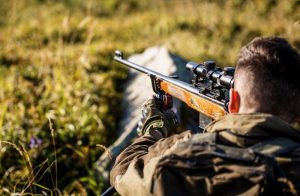
Know Before You Go Hog Hunting
We have put together some tips that will give you helpful information before you head out on the hunt.
SIGNS TO LOOK FOR
Tip 1: Signs Of Rooting
Wild hogs will use their snouts to find food by rooting through vegetation. The most recognizable sign of a hog being in the area is uprooted soil.
Tip 2: Hoof Tracks
Similar to a deer’s hooves, a hog’s tracks will be wider and rounder.
Tip 3: Signs Of Wallowing
Wild hogs will search out ponds and creeks and dig up the land around them. They will then wallow in the mud to cool themselves down.
If you see these signs around even smaller bodies of water, there will be hogs close by.

FIREARM AND AMMO
Tip 4: Choose The Right Firearm
When hunting other prey, like deer, if you hit your target with a non-fatal shot, a deer will run away, and you will have to track it.
If you are hog hunting and hit a wild hog with a non-fatal shot, you are the one who will become prey.
Hogs are likely to attack when shot. Use a multi-shot high-powered rifle, pistol, or revolver when hunting these aggressive animals.
Tip 5: Know Their Anatomy
On a feral pig, the organs in their body are low and forward.
Because of this, the most effective shot placement is behind the ear and broadside. You also want the shot to be as humane as possible.
Here is a video on How to hunt hogs and best shot placement.
Tip 6: Wild Hogs Will Play Possum
If you have brought your prey down, you would not be amiss to approach cautiously. When you are 15 to 20 yards away, reshoot the hog.
Hogs are shifty characters and will often play dead. It is important to know that a hog’s fat can plug a bullet’s entry and exit wound.
That can slow or stop blood loss and enable the hog to rise from the apparent dead when you least expect it.
Tip 7: Choose the Correct Ammo
The tip about hogs playing possum brings us to the importance of choosing the right ammo.
Get suggestions from your local ammo dealer, but high-velocity ammo like a hollow-point hard-cast bullet can pack a punch that will bring them down and keep them down.
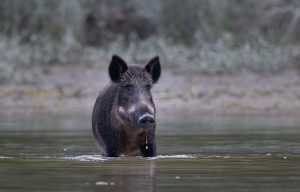
KNOW YOUR PREY
Tip 8: Use Their Territorial Traits Against Them
When wild boar hunting, know a bit about your adversary. They have a rotten temperament and love a good fight.
Ready for a tussle, they will respond to devices like a hog squealer call.
Just like a call that you might use for ducks or turkey, a hog caller will help to tempt a hog to leave the thicket just spoiling for a fight.
Tip 9: Know What Hogs Eat
A hog will eat a lot of things but do have preferences. Hogs are omnivores, meaning they will have a mixed diet of plants and meat.
Here are the four foods that a hog will hunt for:
- Roots
- Berries and seeds and nuts like acorns
- Leaves and bark
- Insects, fish, rodents, bird eggs, snakes, frogs, earthworms and mollusks
A hog over 100 pounds needs about 4000 calories a day, which is a whole bunch of foraging.
Tip 10: Know What They Consider Hog Heaven
When looking for an ideal environment to settle down and raise a family, hogs will set up camp in areas with three primary qualifications:
- A reliable water source
- Shelter from predators
- Little, if any snowfall (which is why they love Florida!)
If an area has these three requirements, the chances are good that you will find some hogs in hog heaven.

CREATURES OF HABIT
Tip 11: How They Catch Some Z’s
Wild hog families will sleep together in one spot called a shelter. They will line the shelter with branches and hay if hay is available.
Swamps, tall grass, and shrubs are favored areas for a wild hog to construct a shelter.
These creatures are heavy into snoozing and will be down for the count about 12 hours out of the day.
Tip 12: Hogs Are In A Rut
While the term “rut” can refer to a hog’s romantic season (November to January), it also applies to the fact that hogs are creatures of habit.
So much so that they seldom change their patterns. They will use the same travel lanes, crossings, and wallows.
The only reason a hog will change their pattern is if their source of food or climate changes.
Knowing this, once you have located one of these spots (like a water source), stick with that area and you are likely to spot them.
SAFETY FIRST!
Tip 13: Wild Hogs Are Dangerous
As the saying goes, you don’t have to be faster than the hog, just faster than the guy you are hunting with.
Just know that a wild hog is going to be faster than you. A wild hog can run up to 25 mph and jump distance of 59 inches.
You don’t want to be on the business end of their tusks or hooves.
If a wild hog has young with them or is injured, you can expect them to be brutal. Don’t ever let your guard down.

Tip 14: Hogs Are…well, Hogs!
Male wild hogs in Florida can grow to 150 to 210 pounds and be five to six feet long and 30 inches shoulder height.
Females will be anywhere from 120 – 170 pounds and about 28 inches in height. You might think that all that weight would slow them down. You would be wrong.
Tip 15: Choose A Safe Spot To Hunt From
If at all possible, hunt from a tree stand. Not only is your view of the proceedings better, but you are also safely out of reach.
When hunting from the ground trying to make sure a tree is handy in case of an emergency. And any time a wild hog is charging you, it is an emergency.
Tip 16: Don’t Go Alone
When hunting for hogs, it is not the time to go solo. This is one of the games that you are going to want back-up for. At the very least, take a cell phone, but a hunting buddy is preferable.
ON TO THE HUNT
Tip 17: Bait and Wait
It is legal to set out bait for wild hogs, but only on private land, and it is a tactic hunters employ to up their chances of success.
After setting out the bait, wait downwind, or use a scent killer.
Here are some of the baits that a discerning hog prefers:
- Shelled corn
- Acorns
- Overripe fruit
- Nuts
- Sweet potatoes
And this is really a hoot; if you soak your bait in beer, they will go wild for it! Just remember that the beer-soaked bait is for the hogs!
Tip 18: Best Times Of Day For Hunting
The best time for hunting your future barbecue is early morning and late evening. This is when the hogs are most active.
Like the rest of us, about noon hogs want to take a break from their labors and rest. They can get pretty testy if you decide to appear and announce that the game is afoot.
This is not to say that you can’t try rousing them from their break. Just know that they rest in their shelters as a group.
So if you prod one, you will have the whole gang on your hands.
Tip 19: Whether They Move Can Depend On The Weather
Mother nature plays a part in a hog’s decision to venture out or stay home and watch TV.
When there is low atmospheric pressure, scents will linger low on the ground and so the hog will have a heads up that Mister Rogers is in the neighborhood.
On those days, try to hunt from a tree stand if possible. Always, always be downwind, or you might as well stay home.
The colder it is, the farther a hog will travel in search of food as it needs to maintain its warmth.
The little darlings also like a pleasant walk in the rain and while you might think this is all wet, it is right up their alley.
DON’T CHANCE IT!
Tip 20: Make Sure The Hog Is Healthy
As with any feral animal, wild hogs can carry parasites like roundworms and diseases like pseudorabies.
Although this disease is not related to rabies as the name suggests, it can be fatal for livestock and pets.
If you see any signs of disease or parasites in the hog you have bagged, discard the carcass. It is not safe to eat.
Tip 21: Field Dressing
If you are going to dress the bagged hog in the field, always wear disposable rubber or plastic gloves. Make sure you are wearing eye protection too, in case of any splashing.
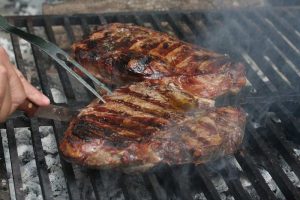
HEAT UP THE BARBECUE
Tip 22: More Than Meat
You might be an avid hunter of a variety of games, but there is more to hunting wild hogs than fresh meat.
We spoke before about how hogs wreak havoc for farmers and fragile ecosystems. They also will destroy turkey nests looking for eggs.
Hogs compete with deer for food and often drive deer from the area completely.
When you hunt wild hogs, you are also participating in a conservation effort that is no small deed and has profound benefits to the environment.
Tip 23: Pork. The Other White Meat
This is not so much a tip as it is information. Wild hog does not taste gamey or greasy.
Still, it doesn’t taste like domestic pork, either. It’s a bit sweeter, with a hint of nuttiness, and is noticeably leaner and firmer.
A bonus is that wild hog has one-third less fat; it has fewer calories and less cholesterol than domestic pork.
A FEW RECIPES TO TRY
We leave you with this link to Wild Hog Recipes – 3 Popular Ways To Cook Wild Boar.
The first recipe is (what else?) wild boar bacon.
A wild boar rack with whiskey apple recipe follows the bacon. The third recipe is the ever-popular wild hog pulled pork that goes with pretty much any festivity.

IN CONCLUSION
Hunting wild hogs will give you a great chance to outwit a very competent adversary.
They are clever, strong, aggressive, and tasty. A wild hog is not going to make it easy for you.
Even if a wild hog is standing in one spot, they will be rooting which means the sweet spot is in constant motion.
It is the challenge that most hunters love when going after wild boar.
Florida hunting season is year-round, and there is seldom a better opportunity to marry conservation efforts with bringing home the bacon.
Wild hog hunting is doing a good deed and putting meat on the table at the same time.
For the hunter, at least, that is hog heaven!

